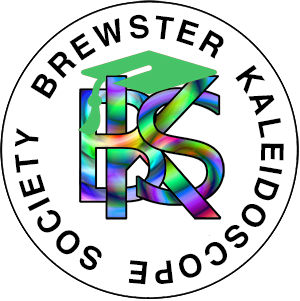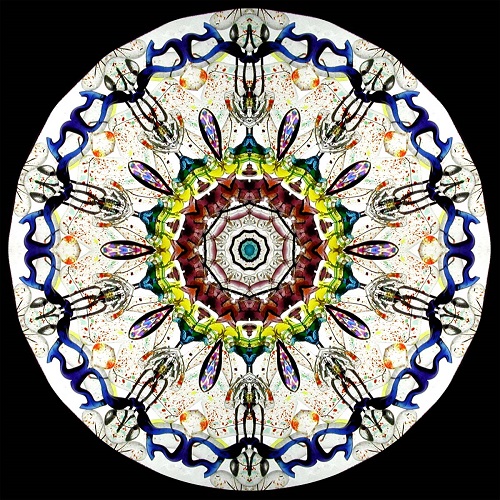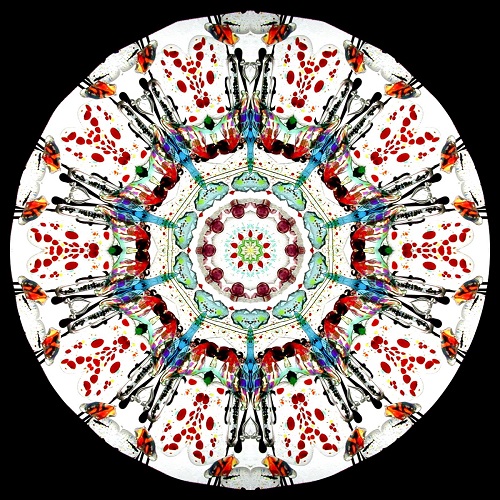Surprise Party
Originally printed in The Washingtonian, June 1998
by William Novak
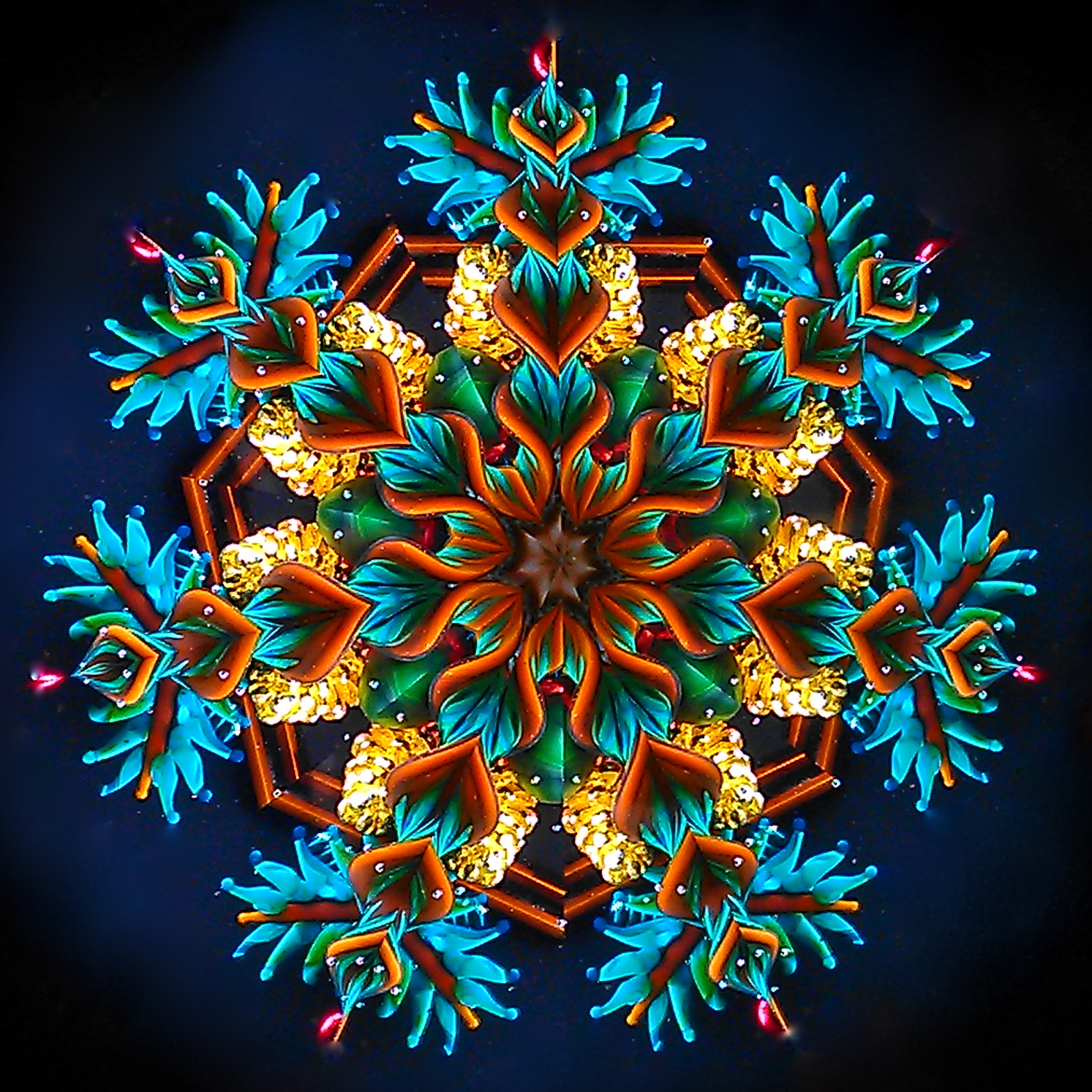
I’m at the breakfast table when my teenage niece, who’s well aware of Uncle Bill’s obsession, presents me with a box of Kellogg’s Kaleido Rice Krispies.
I tear open the box, and as a cluster of kernels tumbles to the table, it occurs to me that these dazzling dots of dye might fit nicely into the object chamber of one of the two dozen handmade kaleidoscopes I’ve accumulated in recent years.
And indeed they do. As we slowly spin the cylinder, the pellets appear luminous and festive. I’m not surprised. By now I’ve learned that a well-crafted kaleidoscope can transform even the most mundane morsel into a radiant symmetrical pattern.
In truth, the breakfast-cereal episode wasn’t the first time it dawned on me that I might have become a little too interested in kaleidoscopes. That possibility arose as I was filling out a form to register for the annual convention of the Brewster Society, the international organization of kaleidoscope artists, dealers, and collectors. My wife wanted to know why I was planning to fly to Chicago merely to look at kaleidoscopes and meet some of the collectors.
When I explained that I was hoping to write an article about these people, her expression was disarmingly transparent: These people? Like you’re not one of them?
Apparently I am, for when my niece returned to Florida, I decided to call the Kellogg’s consumer hotline to advise the company that Kaleido Rice Krispies look really good through a kaleidoscope. Waiting for an operator to pick up, I suddenly felt foolish – what if 16,000 other people have filed a similar report?
“No,” the operator assured me, “you’re the first one.”
Unlike most of the collectors I would meet in Chicago, I have no childhood memories of playing with a toy kaleidoscope. My own addiction began three years ago when I wandered into After the Rain, a crafts shop in the SoHo section of Manhattan.
The back of the store was filled with kaleidoscopes, and I couldn’t resist the temptation to peer through about a dozen large and handsome pieces on the display table. Later that day I returned and purchased a large silver-and-black model whose imposing barrel looked out on a pair of brightly colored stained-glass wheels.
Whatever possessed me to pay $300 for a toy? I loved the sleek exterior and was enchanted by the dazzling images created by those glass wheels. I was also drawn to the idea of owning an imposing kaleidoscope that was also a piece of sculpture.
More to the point, perhaps, I had recently received a generous check for a new book project, and I was hoping to celebrate by treating myself to the sort of extravagant present that would have made me jealous had I spotted it in somebody else’s house.
A year later, in an eccentric gift shop in Woodstock, Vermont, I bought another one. Being on vacation, I asked the clerk to show me every kaleidoscope in the store. In addition to a big brass scope, I also picked up a tiny silver one on a necklace – a gift for my wife, Linda. When I gave it to her, she said, “You obviously love these things. Why don’t you collect them?”
Yes, I thought, why not collect them? Well, among other reasons, I hadn’t realized I could. Besides, they’re expensive.
But if my own wife was suggesting it – well, then, I practically owed it to her to start a collection. And if I did, not only could I enjoy my kaleidoscopes whenever I wanted; I also could show them off to visitors who (I imagined) would be enchanted by these magical objects and would therefore (I hoped) be full of admiration for the man who was suave and debonair enough to have acquired them.
I had a speaking engagement coming up in Philadelphia. Employing that special logic that the truly obsessed will recognize, I made this calculation: I do my best work in the morning, so the rest of the day after the lecture would be shot in any case. Instead of flying right back to Boston from Philadelphia, why not take a train to New York, go over to SoHo for a little collecting, and fly home from LaGuardia that night?
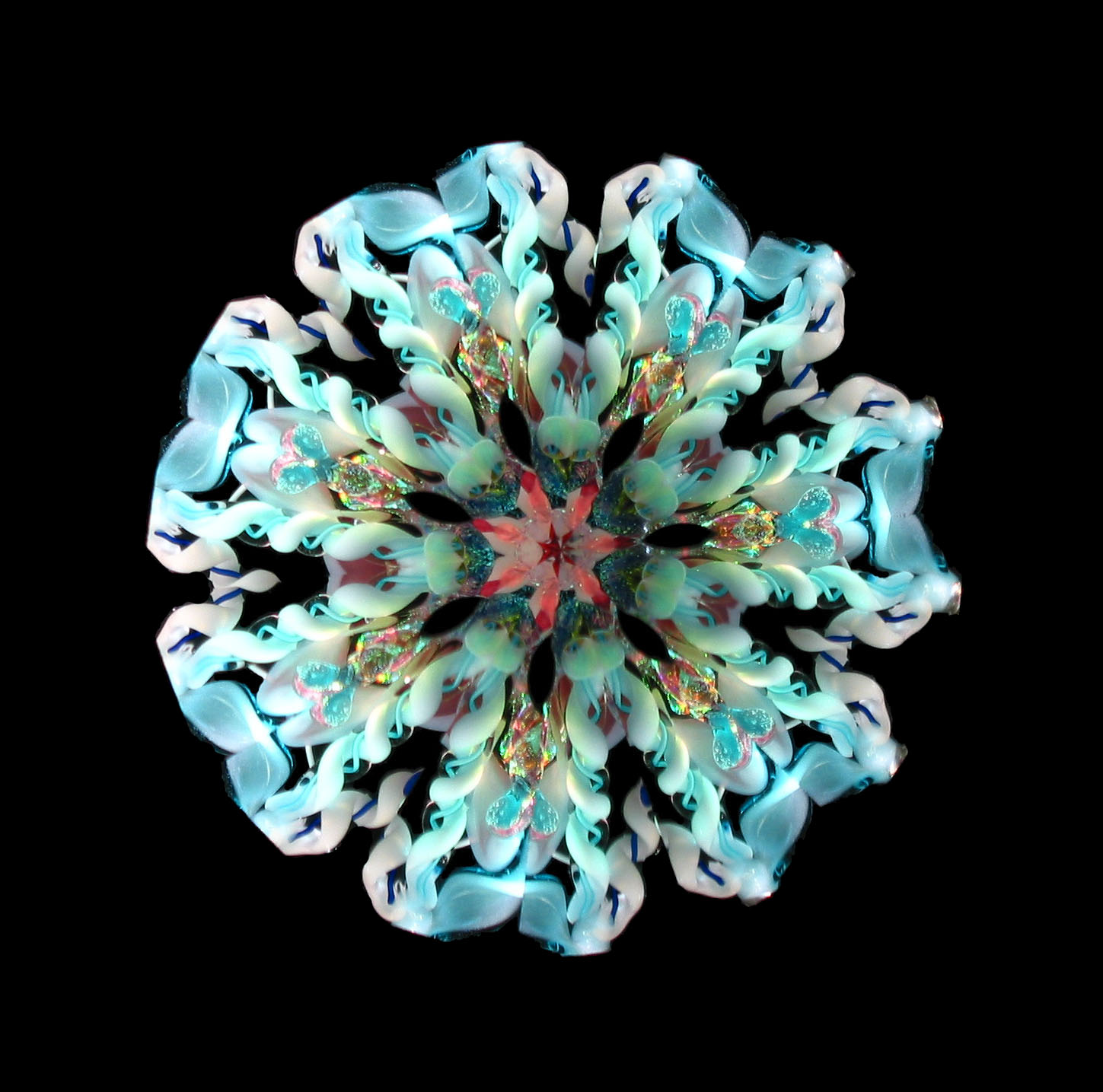
But when I began removing nine new kaleidoscopes from my suitcase, Linda was not amused. In my defense, I pointed out that I didn’t get to New York all that often and that I also had to compensate for all those years when I didn’t collect. Besides, I felt like adding, wasn’t this whole thing your idea?
Soon after I began acquiring them, I noticed that kaleidoscopes conjure up such powerful associations of color, fragmentation, and symmetry that the word itself is almost invariably used as metaphor rather than designation.
Cozy Baker, the world’s leading collector of kaleidoscopes and the founder of the Brewster Society, made a similar discovery when she fell in love with these intriguing instruments. Having decided to write about their history, Baker went to the Library of Congress, where she turned up no fewer than 18 different volumes with “kaleidoscope” in the title – not one of them about kaleidoscopes. Fine, Baker reasoned; hers would be the first.
A charming Bethesda grandmother, Cozy Baker today reigns over the kaleidoscope community like a benevolent monarch. Ironically, her passion for these beautiful objects – she calls them “a surprise party for the eyes” – emanated from a personal tragedy.
In 1981, her 23-year-old son Randall, a gifted sculptor and the youngest of Baker’s three children, was killed by a drunk driver. Within hours, Baker made a vow: that she wouldn’t spend the rest of her life as an embittered mother, always asking “Why?” Somehow, she’d find a constructive way to honor her son’s memory.
Two years later, on a trip to Nashville, Baker found herself mesmerized by a small handmade kaleidoscope in a crafts shop.
“Don’t be silly,” said her companion. “You can’t pay $82 for a toy!”
Baker bought it and spent the flight back to Washington gazing into her new acquisition with such rhapsodic intensity that she ended up leaving all her other belongings on the plane.
A few days later, when a friend showed her an article on handmade kaleidoscopes in Smithsonian magazine, Baker knew she had found her calling. She spent the following year traveling from Cape Cod to California, searching out artists, collectors, and crafts shops.
Soon she was publishing books – her latest is Kaleidoscope Renaissance – putting out a newsletter, and curating exhibitions. The first of these, at North Bethesda’s Strathmore Hall Arts Center in fall 1985, attracted some 10,000 visitors. A number of the artists showed up, too, most of whom had been making kaleidoscopes in isolation. Almost inevitably a movement was born.
A dozen years later, that movement is thriving. In September, Strathmore Hall set up the world’s first permanent kaleidoscope exhibition.
When I learned that the word was derived from three Greek roots – kalos (beautiful), eidos (form), and skopos (to look at) I assumed that the ancient Greeks with their sophisticated sense of mathematics and geometry had invented these beguiling gadgets. If not, they had probably been a favorite knickknack of the Chinese emperors or Egyptian Pharaohs.
Not even close. The first kaleidoscope was patented in 1817 by Sir David Brewster, a Scottish scientist with an interest in the physical properties of light. Brewster, who also coined the word “kaleidoscope,” envisioned two purposes for his new invention. It was an aesthetic device, he noted in his patent application, intended “to please the eye by an ever-varying succession of splendid tints and symmetrical forms.” But it was also a practical tool that might prove useful to “architects, ornamental painters, plasterers, jewelers…and every other profession in which ornamental patterns are required.”
By most measures, Brewster’s breakthrough was a success. During its first three months, some 200,000 of “the great philosophical toy,” as the new instrument was called, were sold in Paris and London, where it seems to have entered the Victorian parlor. But Brewster, who was later knighted for his many scientific successes, realized almost no financial gain from his invention.
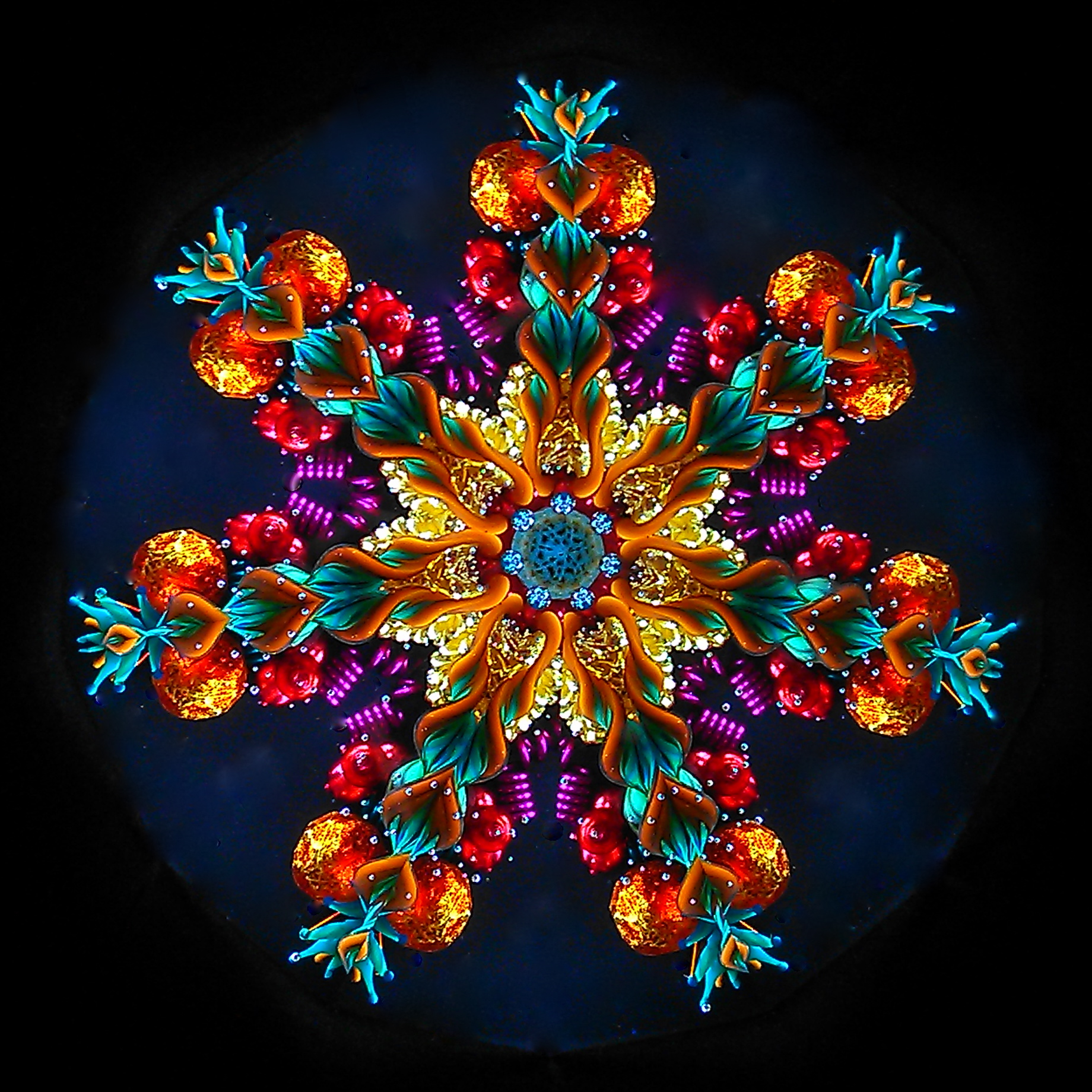
In this regard, his American successors have been more fortunate. According to David Meelheim, owner of Stardust – in 1998 a showroom in Reston that’s successor to the Red Balloon, a Georgetown landmark destroyed by fire in 1993 – some American artisans support themselves by making kaleidoscopes.
Moreover, the current renaissance in kaleidoscope-making appears to be an American phenomenon. Collectors in Europe and Asia report that few first-rate kaleidoscopes are being made outside the United States.
The kaleidoscopes in Meelheim’s showroom vary in price from $2 all the way up to $12,000, but most sell for between $150 and $200. Scopes in this range are often referred to as “production pieces,” items that an artist will turn out repeatedly and profitably for as long as they continue to sell – or until the artist gets bored.
Although there are plenty of fine scopes selling for under $200, serious collectors will pay more to acquire “parlor” scopes – larger kaleidoscopes that sit on a base, or pedestal – as well as limited editions, one-of-a-kind pieces, and antiques.
Antique scopes are expensive: A surviving relic from Brewster’s era might fetch as much as $50,000 at auction, but such prices have little to do with aesthetic considerations. Hidden in the heart of every kaleidoscope is its mirror system, and until just a few years ago, when newer and better materials became available, scope makers used standard household mirrors. Today’s artists use finer-quality “first-surface” mirrors, which produce a sharper and more accurate image.
Mention mirror systems to a collector, and chances are good that you’ll soon be hearing about Charles Karadimos. He lives in Damascus in Montgomery County and is an artist whose mirrors are admired for both their precision and their angles.
Like many scope makers, Karadimos began his career by working in stained glass. In 1980, as an experiment, he put together 14 simple kaleidoscopes and brought them to a local crafts fair. Two hours later, he had sold them all. “People remembered them from their childhood;’ he says, “and nobody had seen one since.”
Like most of his peers, Karadimos favors a two-mirror system, which projects a mandala – a circular, symmetrical image at the end of the barrel – rather than a three-mirror format, where the image appears to extend forever. In recent years, scope artists have begun experimenting with other, more complicated configurations. At the Chicago convention, one artist displayed a much-admired mirror system that projected a 12-sided box.
When I visit Karadimos in his studio, he’s busy making object chambers. Soon he’ll fill them with tiny pieces of sculpted glass, each of which he has handcrafted. Unlike other scope designers, who prefer colorful glass wheels, handmade marbles, or bits of glass suspended in oil, Karadimos makes kaleidoscopes the old-fashioned way, using free-falling glass particles.
Some collectors enjoy the gentle click of the toppling fragments, but what fascinates the artist is the Zen like idea that the particular image that might mesmerize a viewer at this very moment is about to disappear – probably forever. Sir David Brewster, who also used tumbling fragments of glass in his kaleidoscopes, would have understood. “When [an image] is once lost,” Brewster wrote, “centuries may elapse before the same combination returns.”
I ask Karadimos if he can help me calculate the number of different images that could appear in one of his instruments. He explains that as few as ten pieces of glass can arrange themselves into more than 3.5 million patterns – and that’s assuming the pieces line up evenly, which they never do. Add just five more items and you’re up to well over a trillion combinations. Karadimos uses about 50 fragments in a typical scope, which means that the number of potential images is far beyond our joint ability to contemplate
But more isn’t necessarily better, and Karadimos is continually searching for the ideal number of pieces. If he uses too many, they won’t move easily enough to create the optimum number of changes. Too few, they’ll drop so quickly that some of the detail is lost. “My goal,” he says, “is to create a scope that gives you a different view every time you pick it up.”
Of the kaleidoscopes in my own collection, only one, called Shockra, surprises me on a daily basis. Shockra, which resembles a simple spyglass with an aperture at one end and a circle of black glass at the other, features an eight-inch barrel that’s covered with exotic bubinga, or African rosewood. Inside the object chamber are pieces of colored, sculpted glass suspended in clear oil against a black background.
But what makes Shockra so unusual is its distinctive method of illumination: Instead of having the light enter through the back end of the object chamber, Shockra filters it through eight side- lit windows made of dichroic glass, a byproduct of the space program that scope makers have embraced. Because its surface is coated with an ultrathin layer of vacuum-deposited metals, the glass changes color in response to both the nature of the light and the angle at which it hits.
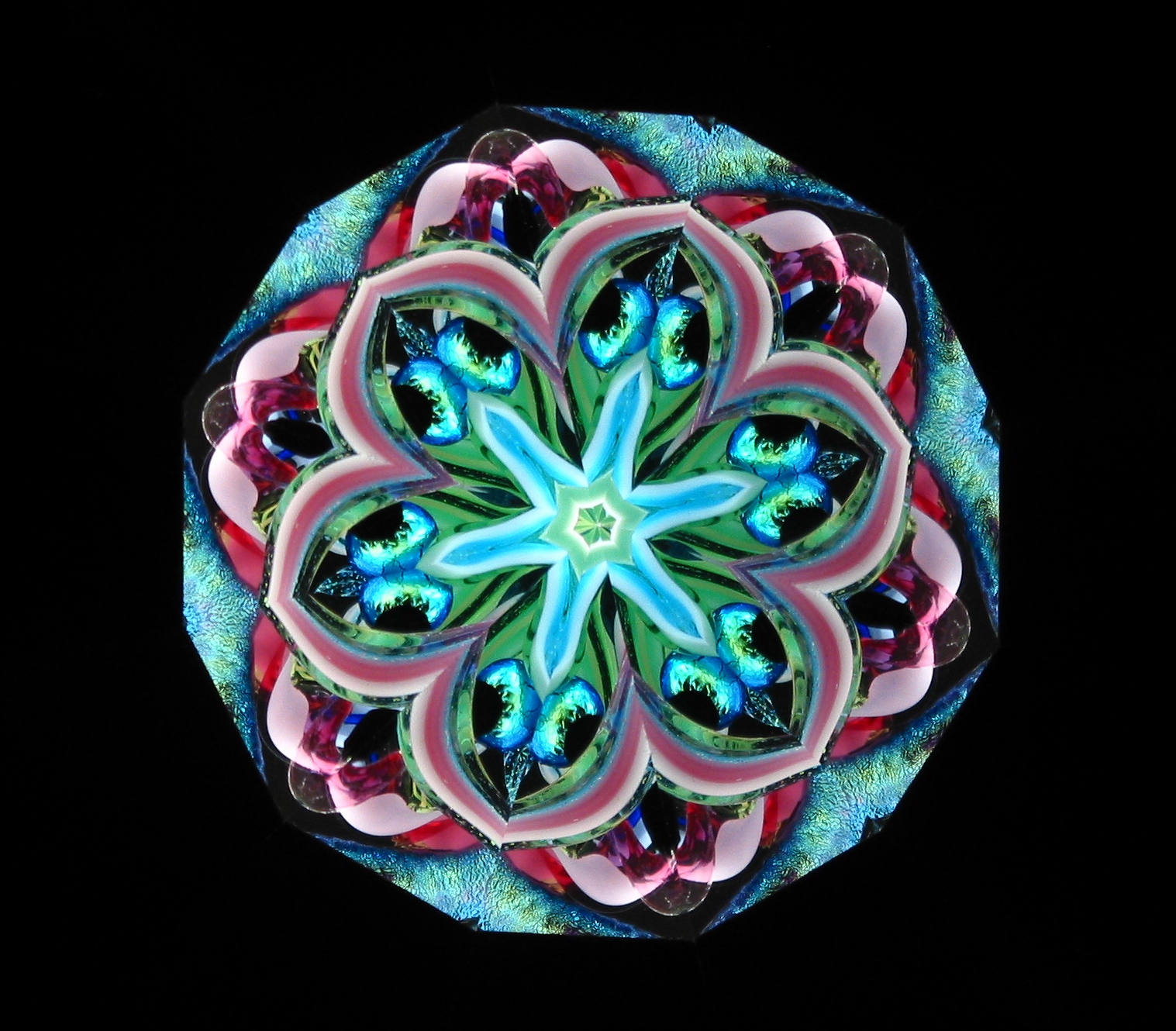
Happily, you don’t have to understand Shockra’s optics to appreciate the results. Look into the eyepiece and you’re greeted by a rich tapestry of pink, purple, indigo, and magenta, punctuated by an occasional brilliant flash as a bright new star explodes out of the black night. At about $180, it’s no wonder Shockra is one of the best-selling scopes of all.
Shelley Knapp, the Oregon artist who created Shockra, is one of about 35 scope artists to appear at the Brewster Society convention.
Traditionally, the gathering kicks off with the weekend’s main event – the unveiling of new scopes, followed by an informal session in the adjoining ballroom that effectively lasts all weekend. Here we can examine the new pieces at our leisure and discuss them with the artists.
As much fun as the new scopes are – and as eagerly anticipated – what is so striking at these gatherings is the lack of social stratification. Several of the attending artists enjoy a substantial following in this community, but you’d never know it from their demeanor or attitude.
Before the convention, I’d heard from several shop owners that scope makers tend to be more communally minded than other artisans – inclined to be cooperative rather than competitive. And indeed, the artists I meet seem genuinely excited by and supportive of one another’s achievements.
Ben Ansley, a former businessman who now makes kaleidoscopes out of alabaster, is eager to tell me about a workshop he attended this afternoon. “Don Doak has developed a wonderful new way of cutting mirrors,” Ansley says. “And what’s his first instinct? He wants to teach it to the rest of us. It blows my mind.”
We’re all wearing nametags, and I spot Tom and Carol Paretti from Arizona, whose newest work, Bubblessence, evoked an audible buzz when it was unveiled earlier today. But I have my own reason for wanting to meet the Parettis.
Beforehand, during a two-day visit to Cozy Baker’s marvelous collection – assumed to be the world’s largest – I examined just about every type of kaleidoscope in existence. I saw one that is actually an aquarium and smaller pieces in the shapes of trains, castles, airplanes, figurines – you name it. I even saw a scope that was carved from an elephant’s tusk.
Baker also owns the world’s largest hand-manipulated kaleidoscope, a 500-pound behemoth that measures 12 feet long and 6 feet high. The artist had been working with stained glass when the owner of a new bar in Cleveland – called Kaleidoscope – commissioned him to produce a scope the size of a small horse. But the bar never opened, and the artist stored this in his basement until Cozy Baker bought it.

My favorite item in Baker’s collection, though, was a production scope by Tom and Carol Paretti with the irresistible name of Feather and Leather. The barrel is covered with rich leather, while the object chamber is filled with a flock of tiny, colored feathers. But instead of twisting a dial or turning a wheel to activate a new image, you squeeze a tasseled perfume-atomizer bulb. The bulb squirts a puff of air into the object chamber, which in turn swirls the feathers into a new design. The results are sublime: a gentle pastiche of luminescent pastels.
I’m not the only one at the convention who admires the Parettis’ work. Door prizes are awarded throughout the weekend, and when one Feather and Leather is given away on Sunday morning, a wave of envy rolls across the room. I, too, am disappointed until I remember that Feather and Leather is easily available for under $200. On my way home, I order one from a dealer, who promises to ship it immediately.
By now I should be blasé, but back home I find myself checking the front porch almost hourly to see if UPS has dropped off my package. When Feather and Leather arrives a week later, my family agrees that even though Dad may be a little nuts, this piece really is extraordinary.
At the convention I ask Carmen Colley, who is known for her flamboyant oversize kaleido-sculptures, if she’s ever included any truly bizarre items in her scopes’ chambers. I thought breakfast cereal was exotic, but Colley, who lives in San Antonio, has found kaleidoscopic uses for coriander, coffee crystals, cicada wings, cat whiskers, moth antennae, a rattlesnake’s rattle, and even live scarabaeid beetles.
A few years ago Colley created a “poison scope” that featured scorpion claws, hemlock, and poison ivy, although she quickly assures me that all of these were safely pressed into a glass wheel. “I don’t know who eventually bought it,” she says. “But I like to think of it as the perfect gift for that special someone you just can’t stand.”
Some collectors see kaleidoscopes as a spiritual aid – a centering device, perhaps, or of use in meditation. Others view them as art, or sculpture, or toys for adults.
Cozy Baker believes that scopes have healing powers, and she gives them to friends who have suffered a loss. I’ve heard about therapists who use them to encourage troubled children to open up and doctors who place them in waiting rooms.
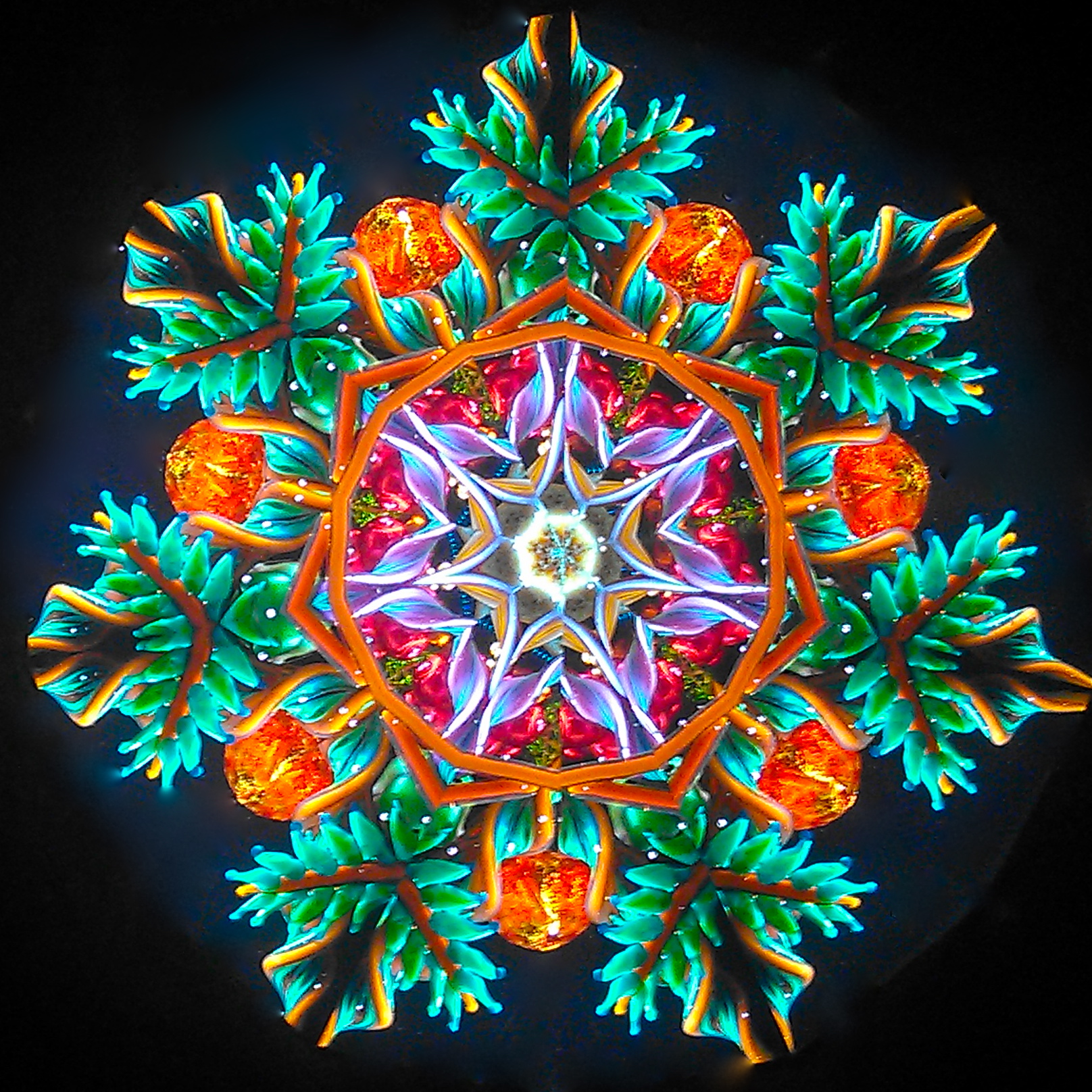
I collect kaleidoscopes because I love them and because I enjoy colorful art that moves and changes when I touch it. If pressed to find some deeper meaning, I’ll also admit to enjoying the paradox that scopes embody: While they afford you a large measure of control, the only way to fully appreciate them is to surrender. And while you can change the image as often as you like, you never really know what the next moment will bring.
Kaleidoscopes also remind us that nothing in life is immune to change; what really matters is how we respond to the continual flow of permutations around us. With enough practice and patience, we can learn to coax the fragments in our object chambers into new patterns that are instructive, inspiring, and even exhilarating.
Photos provided by Charles Karadimos, Randy & Shelley Knapp, and Luc & Sallie Durette.
William Novak, a Boston-area author, is best known as the ghostwriter of the memoirs of Lee Iacocca, Tip O’Neill, Nancy Reagan, Oliver North, Magic Johnson, and Tim Russert. He is also the co-editor of The Big Book of Jewish Humor. In recent years he has been writing corporate histories and private books for wealthy families.
